|
by Hu Jiamin

Photograph by Yaxue Cao
Having disappeared, my mural has lost its ability to be seen, appreciated and interpreted in myriad ways; its consequent vulnerability attracts the authority of homogenous interpretation. In such an abnormal context, I believe the author of the artwork must formulate its sense.
—from my email to Tammy Ho Lai-Ming, co-editor of Cha: An Asian Literary Journal To start my statement, I first need to correct a description that has been widely spread and repeated by the media: Time Discrepancy was a mural paying tribute to Liu Xiaobo. This is not true; the mural as a whole was not about him. Even before the whole incident got reported, I had already explained my point of view to a journalist from the SCMP with a text message: What I want to emphasise is: painting that chair was mainly to express my personal commemoration and grief towards Mr. Liu, but it is not a declaration to the public. It is like many other details in this painting which only concern my personal life and memory. What Mu Xin said was true: "Art is (the artist's) frank and righteous privacy (藝術是光明磊落的隱私)." Then I added: "If the interview is going to be published, make sure to include what I wrote above." That was in the late afternoon of December 15th, 2017, shortly before the opening ceremony of the UABB (Bi-City Biennale of Urbanism\Architecture) in Shenzhen and my subsequent arrest. Having finished the mural just a few hours before, I was extremely tired and still quite occupied. Yet I agreed to take an interview with the SCMP when the journalist contacted me, and it turned out to be the only time I ever talked about this issue to the media. The interview went on in a friendly and pleasant tone. I spent some time explaining several details of my mural to the journalist and her colleagues, though I felt their interest was mostly in the chair. Briefly after the interview was over, feeling concerned that the report might focus too much on the empty chair and amplify its significance, I sent the journalist the text message quoted above. I did not hide my commemoration towards the late dissident, which was supposed to be taboo in China and thus had to become my "privacy." In terms of privacy, I also painted other elements which were very personal to me. All the animals in the mural were the actual animals which had mattered in my life. The dog was the dog that accompanied me when I was living in the countryside of Yunnan—she passed away two years ago, and I painted to express my remembrance of her; the duck was the grown-up, motherless duckling my wife and I saved from the river near our home in Lyon; the cat was our cat—we brought him with us to France from the Beijing hutong. There were elements taken from the paintings I'd created before as well: the window scene, the safety cones and the raven. I also expressed my admiration for Chinese traditional landscape paintings, and I paid homage to the Western masters, most recognisably Leonardo da Vinci—I completely copied one of his drapery studies in my mural. That is why the Mu Xin quotation is very meaningful here, for I deeply believe that the artist's sincerity and individuality are essential to artistic creation. However, the second half of my statement that included the Mu Xin quotation did not appear in the SCMP published article. (That said, I need to make it clear that my arrest had nothing to do with this report, for it was published the day after I was apprehended. It was another media outlet, which had previously released a report about my mural under a shocking title, without contacting me or confirming any facts, that had drawn the police's attention and led to my arrest.) I quoted Mu Xin as part of my own artist statement, not only because of the "private" nature of my work, but also because it was open to the public. It had an immediate and constant audience—it was supposed to be seen, to be examined, to be discussed, to be appreciated or criticised. Therefore, only by making the work "frank and righteous," did I dare to show it to the public. As a matter of fact, I gave a lot of consideration to how my mural would face, echo, respond to and interact with its surroundings and the people passing by. How to combine its public function with my personal artistic pursuit became the main concern of my creation. The mural was painted on one whole side of the outer wall of the Temple of Lord Guan Yu, an important spiritual place for Chinese people. Furthermore, the temple was located at the entrance of Nantou Old Town, an urban village, which was the main site of the UABB, and there was a small square in front of the wall. All of these factors meant it was crucial for me to consider the mural's engagement with the place and the people. I did not want to paint an enlarged image to impress viewers the way many murals do nowadays. I'd also never considered myself a street artist, though I had painted some murals before. My experience in painting was mainly on canvas and the examples I wished to follow were of ancient church and chapel frescoes, rather than glamourous and exciting billboard-like street art. I wanted my work to look modest and environmentally friendly. I wanted it to converse with the audience rather than to amaze them. I wanted it to be a continuation of the surroundings rather than a striking view that would simultaneously attract and block the audience's sight. With these intentions, and taking into consideration the irregular shape of the wall, painting the mural as a life-sized architectural space appeared to be a natural choice. According to its shape, I divided the wall into three parts, thus I could consider myself making a triptych—a typical form in the Western tradition. The two sections on both sides were intended to mirror and echo each other and together highlight the central section, which also served to link the sections on either side. In the particular case of this piece, the left and right sections were the side walls of two buildings of the temple, and the middle section was a fence-wall joining them. Therefore, I transformed each of the left and right sections into a room, and the rectangular central section became a hall, or rather a corridor, connecting the two rooms with doors open at each side. Each room had its own view—I filled the window on the left side with a view of traditional houses and roofs, and the one on the right with a view of a modern urban village (it was an almost-faithful depiction of a spot in Nantou). The two windows showed a clear contrast, as well as the opposition of past and present. As for the hall or corridor in the middle, I decided to paint it into a large floor-to-ceiling window with a view of a traditional landscape, suggesting that rebuilding the connection between past and present can be achieved through nature and the traditional spirit. The theme of UABB 2017 was actually "Cities, Grow in Difference" ("城市共生"), and the concept of my mural responded to it in a rather positive way. The whole creation of the mural was based on this idea. Its title, Time Discrepancy, was also generated from this point. Later on, I developed the design of the painted architectural space. I got the idea of turning it into a space for contemporary art, because the mural itself was a project of the biennale, a big event for culture and art. It was intended to be a memorable experience for local residents, and I was wondering how much of the event they would retain in their memories after it was over. With this in mind, I thought it would be a good idea to literally paint an exhibition, as a souvenir to be preserved for the people of Shenzhen. And since it was painted on the wall of the Temple of Guan Yu, I decided to make Guan Yu the theme of my fabricated contemporary art exhibition. So I painted a mask of Guan Yu and his coloured woodblock print hanging on the "walls" of the "art gallery." The work also featured a red horse, suggesting Guan Yu's steed, the Red Hare, yet based on an actual horse I'd come across in the French countryside a few days before I left for Shenzhen. The horse was eating the leaves of a provision tree (a common ornamental plant in southern China with the local name "fortune tree"). It was planted in a drum-shaped flowerpot, which itself was based on a drum I'd found inside the temple. I'd also come across a costume blade of Guan Yu in the temple, and I painted it as well, opposite Leonardo's drapery study which I'd painted in green. (I'd recalled that in some folk operas, Guan Yu had a robe of a similar colour.) I chose to copy that particular drapery study because it had an angle suggesting the drapery touching the floor, hence I painted the drapery on the "wall," with some of its lower part painted on the "floor," in order to make it look like graffiti, a mural within a mural. 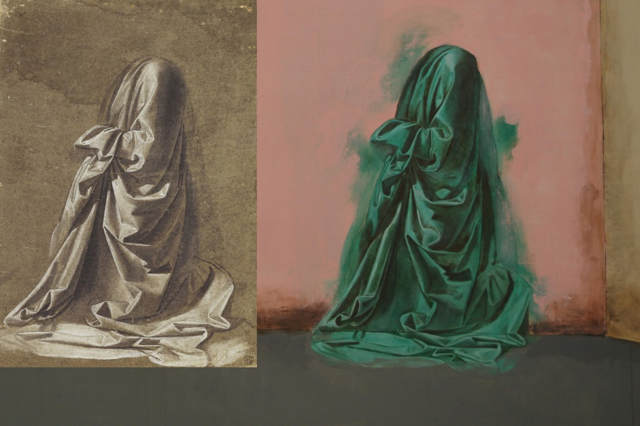 Inventing a nonexistent contemporary art exhibition was a process full of fun. Generally speaking, contemporary art galleries are filled with installations instead of paintings. I felt that painting an exhibition constructed of installations would bring an extra layer of meaning to the work, as well as heightening the sense of absurdity that is often found in contemporary art exhibitions. I put a mild sense of sarcasm in my rendering of the space, but it was playful, not cynical. I even painted the surveillance cameras—despite the fact they suggest that "you are being watched," surveillance cameras also somehow feel like they are supposed to exist in an art gallery. However, I gave them an appearance that looked more awkward than scary. Through the placement and contrasting of the objects I painted, there was a lot of space for my creativity to explore: the two rooms on each side both had a vault, which made them look like Western chapels caged inside Chinese buildings; a white and smooth bathtub, carrying an odd-shaped stone, drew an interesting comparison with the Leonardo's drapery study, in terms of the look and feel of the textures; behind the stone, on the "wall," I painted some bamboo-like graffiti, for bamboo and stone is a classical collocation in the Chinese aesthetic. However, this was actually Mao's calligraphy camouflaged as a bamboo painting, as I was trying to bring the legend of Guan Yu composing a poem disguised as a bamboo painting into a modern context. And even though the bamboo-calligraphy was hard to recognise word by word, it was not difficult for Chinese people to identify Mao's handwriting. It actually read: "Nature has excelled herself in the Fairy Cave, On perilous peaks dwells beauty in her infinite variety" ("天生一個仙人洞,無限風光在險峰"). In the piece, evidently, the "peak" referred to the strange stone in the bathtub, and the "Fairy Cave" referred to the moon gate in front of the bathtub and the stone. 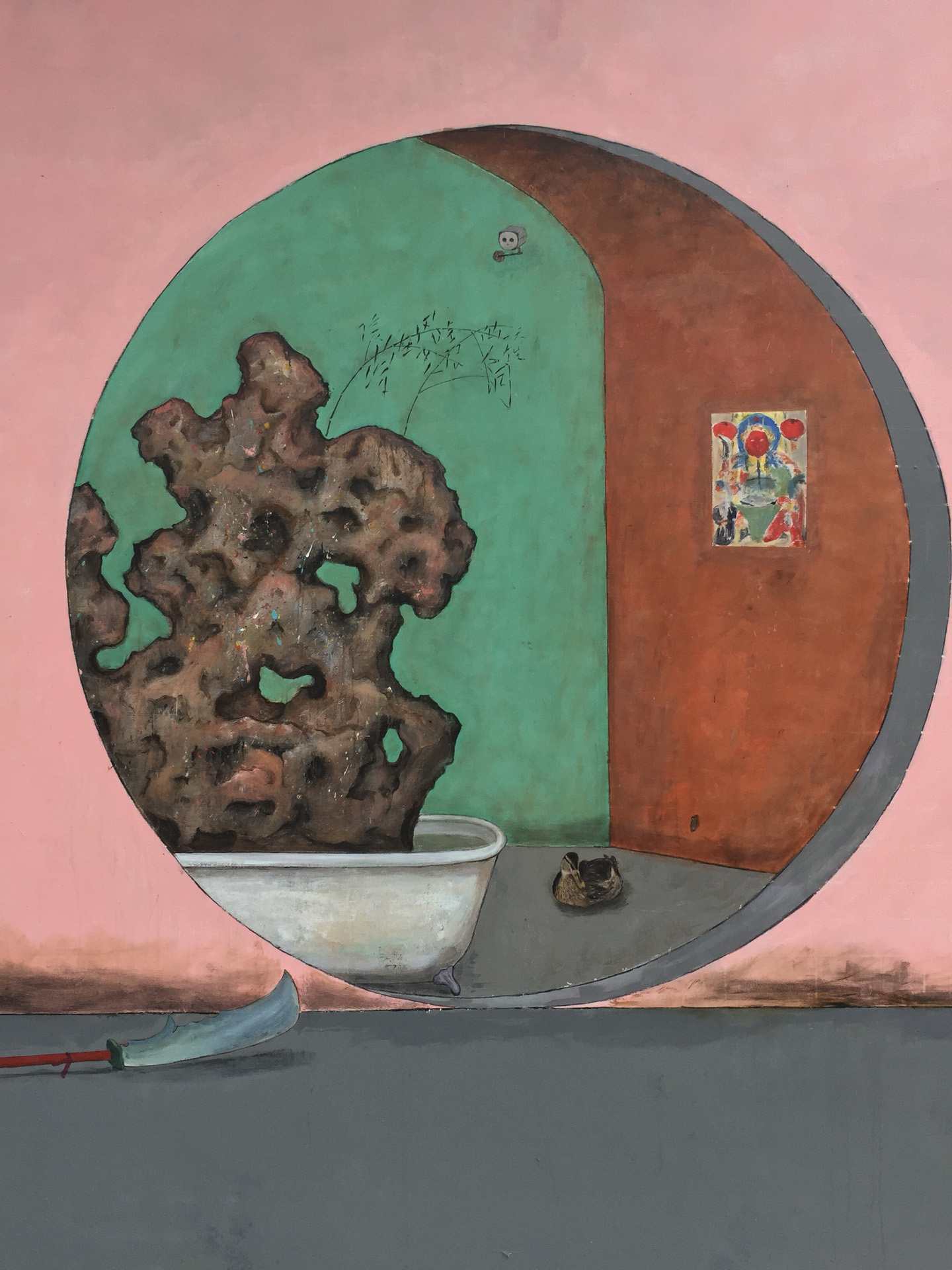 I chose not to paint any people inside, in order to make the space look even more empty—another general impression one often gets in contemporary art galleries. However, this choice invited the audience to engage with the work. I did not want the space to be cold and rejecting—a feeling one often has in galleries; on the contrary, I wanted it to look warm and welcoming. To this end, I painted the "walls" and the "ceiling" colourfully, even though in general, I tend to use more greyish tones in my work. The animals in the mural also brought a lively and neighbourly atmosphere to the piece. Based on my own observations during the time I was painting, people were mostly attracted to the animals—they constantly walked over to them, observed them, touched them and took photos of them (and with them). I had the idea of portraying an empty chair in the mural, as soon as I had decided to paint an architectural space. I was conscious of the symbolism and references it would potentially evoke. I did consider the story of the empty chair in Oslo's city hall, but I also instantly thought about the chairs painted by Van Gogh, and Gauguin, and even Andy Warhol. In the early stage of mural-making, I had not decided on which chair I would eventually paint. As the process evolved, however, I began to have a clearer idea about the chair. For me, an empty chair is a significant item in a museum or gallery—an object for the guard, and/or for the audience to sit on. An empty chair always looks like an invitation, or a temptation, an enticement for involvement. As I painted the "walls" and the "ceiling" colourfully (green, pink, red, purple, orange, yellow and beige, to be exact), I realised that the whole mural was lacking blue, so I thought painting the chair in blue would balance the image. Then, like destiny, I discovered that the chair at the Nobel Prize awards ceremony was blue. So I painted it. It wouldn't be honest to say I was unaware that painting the blue chair might bring me trouble. However, I certainly did not expect the trouble would be fatal (the totally destruction of the mural); nor could I ever have imagined that I would end up spending a few days behind bars. The worst thing I could think of was that the UABB team would order me to change the appearance of the chair. Technically speaking, it was their job to communicate with the artist if there were any problems, and the biennale team was supposed to be a professional and mature organization. Holding such understanding and confidence—which turned out to be misplaced—I considered that my responsibility as an artist was above all to ensure the sincerity and faithfulness of my creation. I would not self-censor my own work before it was even created. After it was finished, if I were to be asked by the curatorial team to modify my piece, I would have been willing to negotiate, adapt and cooperate, for I understood the context in China. But I had to fulfil my artistic duty first. I regarded the act of painting the blue chair as my resistance to censorship and to self-censorship—as I have explained already, the symbolism of the chair was personal rather than political, and if one still wishes to overlook the political significance in it, this was the message I tried to deliver.
 The chair was painted four or five days before the mural was completed. During that time, nobody—neither the curatorial team nor the common audience—paid any special attention to it. In fact, it was not very noticeable, even though it was placed in the centre of the picture. It was simple and humble, just what a chair is supposed to be. Also, as the mural stretched parallel to the path people walked on, most people did not walk towards it. Instead, they usually passed by the left or the right side of the mural and could not really take in the entire image at first glance. What people saw first were the objects that were closest to them, depending on which direction they walked from. Only when they stopped and looked at the whole mural, would they get the sense of the entire painted space. I found that by depicting a life-sized architectural space, I actually was able to overlap Western and Eastern ways of seeing a painting. With a distant and general view, the audience would experience Western fixed-point perspective, but if the audience checked out the details of the mural more closely, they would only see what was directly in front of their eyes without perceiving the painting's whole structure, hence the sense of fixed-point perspective would dissolve. (The latter is supposed to be the way one should look at the traditional Chinese handscrolls.) Regrettably, by only looking at the photos of the mural, one cannot experience this duality. 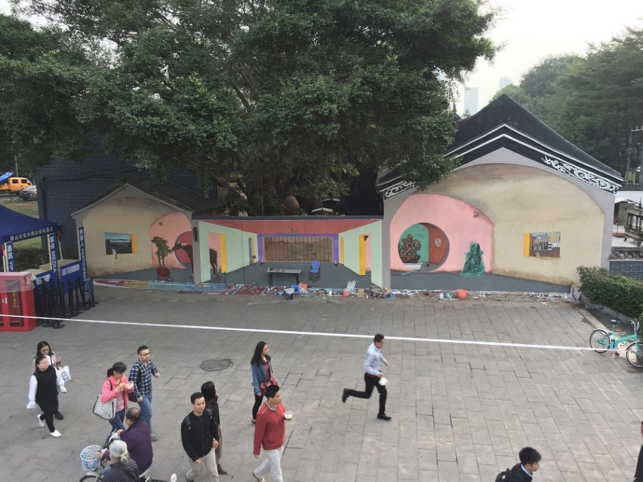 The mural took me almost three entire weeks of hard work. Most of the time, I was working alone. I suffered strong irritation caused by the smoke of the constantly burning incense from the temple—a sign of frequent visits, which in a way proved the importance of the place and the worth of my hard labour. It seemed to me that I was executing a service to the local people. As some articles did note, I painted Mao's famous slogan "Serve the People" vaguely on the "wall" above the landscape view in the centre of the mural, yet rather than insinuating its associated political sense, I was mostly wanted to present its literal meaning. As a general rule, I do believe art and artists should serve the people. But do people also share my belief? With the time slowly passing, by carrying on my practice through earnest and exhausting labour, I felt I was following the path of the past masters whom I truly admired, for they spent months and years facing the walls and ceilings, though they painted on the inner walls of churches and cathedrals, while I was painting on the outer wall of a temple in contemporary China. But does this artistic stance have meaning in a time when everything is about being fast and fashionable and innovative? I, a Chinese living in the West, travelled back to my own country and started to paint a large mural with jetlag, attempting to bring to the place and the people something of both personal and universal value, but did they need it, and did they care? It was quite predictable from the beginning that my experience in China this time would be confronted by a divergence of values and contexts, as well as by the gap of our time and the past. The title Time Discrepancy was a summation of all the contents of my mural; it was also a reflection on an artist's own condition. During the process of creating this imaginary art gallery, the more I revealed and exposed my ideas and crafts to the public, the more inward and intimate it turned to be. I felt that it had become my own memory box, all the details carried my visual and emotional impressions and experiences: the cement floor, the green ceiling fan, even Mao's calligraphy. It was certainly not a jail or an interrogation room, as the media and the police put it. They got it all wrong. The red bars splitting the background landscape were not prison bars; they were the wooden slats commonly used in both traditional and modern architecture (from the photos one can see that the width of the slats vary due to perspective, for their cross section was rectangular). Painting the slats was meant to imply our separation from nature and reality. I had no intention of converting my mural into a prison, except maybe in the sense that an artist is the captive of his/her own creativity. I painted my own art gallery, my own memory box, my own temple, my own "ZONE." I had indeed paid tribute to Tarkovsky: the horse, the dog, the raven—all typical symbols of his cinematic world. I had thought about the nature of painting; I was aware that throughout history, large-scale paintings played the role that cinema has played in modern times, and I wanted to bring that experience back to the people in Nantou. I had thought about the life of Tarkovsky, who was such a pure and sincere artist, yet throughout his career, his works were overcharged with political significance by his country, and he had to go into exile in order to maintain the integrity of his art. I did not expect a similar fate would happen to me. I did not know my own painting would become my prison. 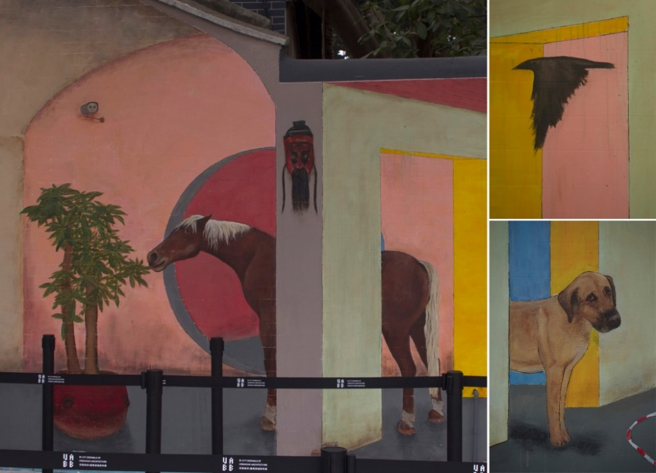 I never went to see the destroyed mural after I was released from the detention centre. It was too painful. From photos sent by friends, I saw that it had been first painted over with blue paint, and some days later, it had been painted over again with white paint. Why this second coat? I have no idea. Perhaps the authorities realised that blue was the colour of the chair, so they had to censor the colour as well, in order to make sure it was removed from people's memory. The UABB closed down just a few days ago, and I haven't been contacted by the UABB team since the day I was arrested—the whole thing seems to have never happened. I wonder about the people in Nantou who witnessed me painting the mural every day—do they still remember that there was once a mural that everyone found beautiful? Will they think about what has happened? Do they have questions? I remember once in those mural-making days, after I'd sketched the wooden slats onto the landscape image, a man in his forties came to me and asked: "Why did you cut the landscape with those lines? It was more beautiful before!" I replied: "But art is not just about being beautiful." Surprised by my answer, he repeated what I just said and murmured: "That's an interesting point." At that moment, I was almost certain that I had actually brought something new to the local people.   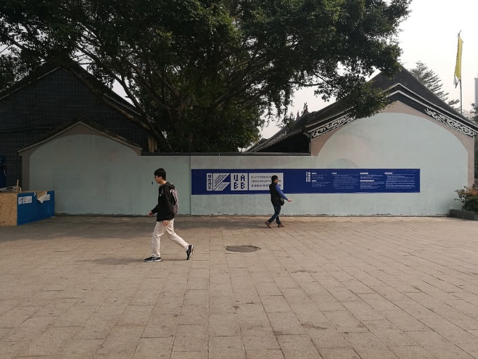 |